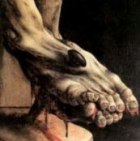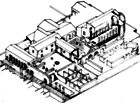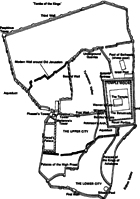The Way of the Cross: Via Dolorosa
Questions for Bible study groups
- Why couldn’t Jesus carry his cross to the place of execution?
- Who was Simon of Cyrene?
- Who were the women in the crowd, and what did they do?
- How did Jesus respond to them?
In brief: In his weakened state Jesus could not carry the cross. Simon of Cyrene helped him. A group of women in the crowded Jerusalem streets mourned for Jesus, the condemned man, already close to death.
Simon of Cyrene carries the cross
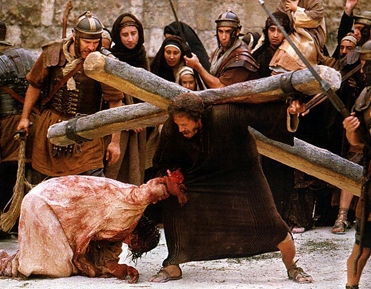 Jesus and two other condemned men were taken by soldiers from the praetorium in Jerusalem to the place of execution.
Jesus and two other condemned men were taken by soldiers from the praetorium in Jerusalem to the place of execution.
A condemned man usually carried the cross to the place of execution, but Jesus was so exhausted and weakened by the beatings that by the time they came near the city gate, a passer-by was hauled in to help carry the crossbar.
This horizontal piece of the cross (not the whole cross as shown in traditional paintings or in the film still at right) was usually carried by a condemned prisoner to the place of execution. The fact that Jesus had to be helped seems to indicate that he had fallen and been unable to rise again to his feet, even at the brutal urging of the soldiers.
Who was Simon of Cyrene?
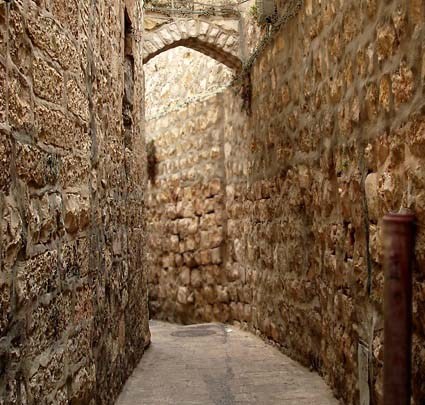 The man who helped him, Simon of Cyrene, came from North Africa. Cyrene had a large colony of Jews – the Jewish historian Josephus notes a Jewish community in Cyrene (Against Apion 2.44, Antiquities 16:169) and Simon must have been one of them, travelling to Jerusalem as a pilgrim to celebrate the feast of Passover.
The man who helped him, Simon of Cyrene, came from North Africa. Cyrene had a large colony of Jews – the Jewish historian Josephus notes a Jewish community in Cyrene (Against Apion 2.44, Antiquities 16:169) and Simon must have been one of them, travelling to Jerusalem as a pilgrim to celebrate the feast of Passover.
His sons are also mentioned in the gospel narrative. This must mean that later on they became well-known members of the early Christian church.
His son Rufus may even be the same Rufus who appears in Romans 16:13, where Paul writes ‘Greet Rufus, chosen in the Lord; and greet his mother, a mother to me also.’ It is tempting to think that Simon’s action in helping Jesus had repercussions for the whole family, even after Simon himself died, and that his wife and sons were drawn into the greater Christian family.
See the blue text in What The Gospels Say at end of page
The women of Jerusalem mourn for Jesus
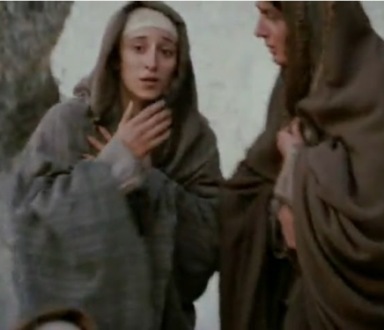 The narrow streets leading to the place of execution were densely crowded. People were naturally curious to see a man passing to his execution, and in fact the sight of a tortured man on his way to a cruel death was meant to intimidate them and act as a deterrent.
The narrow streets leading to the place of execution were densely crowded. People were naturally curious to see a man passing to his execution, and in fact the sight of a tortured man on his way to a cruel death was meant to intimidate them and act as a deterrent.
Among this crowd were a group of women who raised an anguished death-wail for Jesus. But Jesus responded with words that were, in effect, a death-wail for Jerusalem. He urged them not to pity him but to pity themselves, for a day was coming when they would rue having children.
His words echo the opening words of Isaiah 54: ‘Sing O barren woman who never bore a child…’ Barrenness and childlessness were seen as a curse among the Jews, but if this was how the Romans treated an innocent man, how much worse would be the fate of rebellious Jerusalem in the years ahead. If these women bore children they would have to contend not only with their own suffering, but with the sufferings of their children. People would long for death to free them.
Were these women from Jesus’ extended family, or Galilean disciples and friends? It’s probable, but impossible to tell for sure. We assume they must have known him well to have felt such grief and horror.
See the green text in What The Gospels Say at end of page
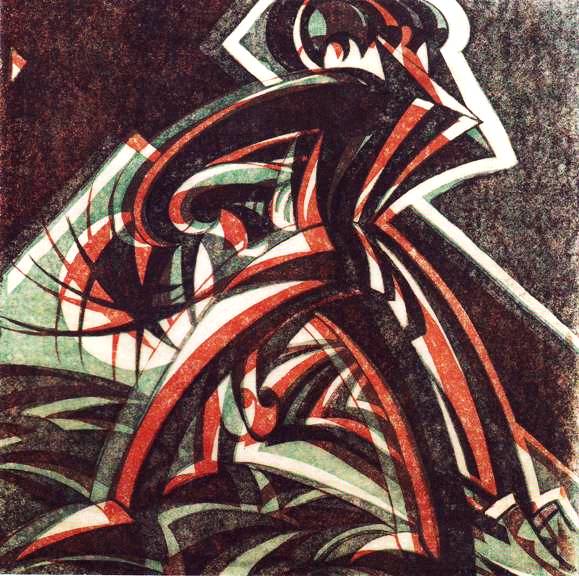
Jesus Falls the First Time, Station III of the Way of the Cross, Sybil Andrews, 1962
This picture captures the juddering sound of the heavy cross hitting the stone road
Return to top
What the Gospels say
1 Simon of Cyrene helps Jesus: Read the blue text
2 The women of Jerusalem mourn: Read the green text
Matthew 27:32
As they went out, they came upon a man of Cyrene, Simon by name; they compelled this man to carry his cross.
Mark 15:21
21 And they compelled a passer-by, Simon of Cyrene, who was coming in from the country, the father of Alexander and Rufus, to carry his cross.
Luke 23:26-32
26 As they led him away, they seized a man, Simon of Cyrene, who was coming in from the country, and they laid the cross on him and made him carry it behind Jesus.
27 And a great number of people followed him , and among them were women who beat their breasts and wailed for him. 28 But Jesus turning to them said, “Daughters of Jerusalem, do not weep for me, but weep for yourselves and for your children. 29 For behold, the days are coming when they will say, ‘Blessed are the barren, and the wombs that never bore, and the breasts that never gave suck!’ 30 Then they will begin to say to the mountains, ‘Fall on us’; and to the hills, ‘Cover us.’ 31 For if they do this when the wood is green, what will happen when it is dry?”

